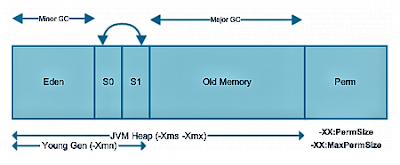What is JBoss?
Red Hat JBoss Enterprise Application Platform 7
Features of JBoss EAP
The standalone server operating mode represents running JBoss EAP as a single server instance.
The managed domain operating mode allows for the management of multiple JBoss EAP instances from a single control point.
Below is the snap of Standalone & Domain topology.
********************************************************************************************
What is Domain Management?
Domain Controller:
A JBoss EAP 7 domain controller is able to administer JBoss EAP 6 hosts and servers, as long as the hosts and servers are running JBoss EAP 6.2 or later.
********************************************************************************************
What are Subsystems, Extensions, and Profiles?
Reference link :
https://access.redhat.com/documentation/en-us/red_hat_jboss_enterprise_application_platform/7.2/html/configuration_guide/index
https://access.redhat.com/documentation/en-us/
https://developer.jboss.org/thread/266415
Thanks :-)
- JBoss is a Middleware application server like a Weblogic, Websphere application server, glassfish and many more.
- Initially, JBoss is an opensource and cross-platform application server, then it is acquired by REDHAT.
- JBoss is still available as an opensource now it is named as Wildfly application server.
- The new version is Wildfly16 & Redhat JBoss EAP version 7.2
Red Hat JBoss Enterprise Application Platform 7
- Red Hat JBoss Enterprise Application Platform (JBoss EAP) 7.1 is a certified implementation of the Java Enterprise Edition (Java EE) 7 full platform and Web Profile specifications.
- Major versions of JBoss EAP are forked from the WildFly community
- JBoss EAP 7.1 is similar to WildFly 11.
- JBoss EAP provides two operating modes for JBoss EAP instances: standalone server or a managed domain.
- The standalone server operating mode represents running JBoss EAP as a single server instance.
- The managed domain operating mode allows for the management of multiple JBoss EAP instances from a single control point.
Features of JBoss EAP
- Java EE 7 compliant (Build using JAVA 7)
- Managed Domain (high availability)
- Management console and management CLI (command line utility)
- Simplified directory layout (Domain & Standalone directory separate)
- Modular class-loading mechanism (stop & restart time enhanced)
- Streamlined datasource management (datasource can be configure using cli / console)
- Patching (command & console) & upgradation. (using tool)
The standalone server operating mode represents running JBoss EAP as a single server instance.
The managed domain operating mode allows for the management of multiple JBoss EAP instances from a single control point.
Below is the snap of Standalone & Domain topology.
********************************************************************************************
What is Domain Management?
- DOMAIN MANAGEMENT (CENTRAL MANAGEMENT POINT)
- The domain system provides management of multiple JBoss instances from a single control point.
- A domain consists of one domain controller, one or more host controllers, and zero or more server groups per host.
- 1 (domain controller ) << >> 1 or more (host controller) << >> 0 or more server groups per host
- A domain controller is a central point from which the domain is controlled. The domain controller is also a host controller.
- A host controller is a physical or virtual host that interacts with the domain controller to control the lifecycle of the application server. Each host can contain multiple server groups.
- A server group is a set of server instances which have JBoss EAP installed on them and are managed and configured as one. The domain controller manages the configuration of and applications deployed onto server groups.
- Default configuration file: EAP_HOME/domain/configuration/domain.xml
- The domain.xml file contains profiles (default, ha, full & full-ha) for servers.
- A Profile contains the detailed settings of the various subsystems available in that profile. The domain configuration also includes the definition of socket groups and the server group definitions.
NOTE:
A JBoss EAP 7 domain controller is able to administer JBoss EAP 6 hosts and servers, as long as the hosts and servers are running JBoss EAP 6.2 or later.
********************************************************************************************
What are Subsystems, Extensions, and Profiles?
- JBoss works on subsystems: Eg. For instance, if an application requires a database, a datasource can be configured in the datasources subsystem and accessed by that application after it is deployed to that JBoss EAP server or domain.
- Extensions: An extension is a module that extends the core functionality of the server. Extensions are loaded as they are needed by deployments, and are unloaded when they are no longer needed.
- Profiles: Profile is a set of subsystems combined for different purposes. For domain-mode, four profiles are defined by default. (default, ha, full, full-ha) For standalone-mode, an un-named profile is set.
Configuration File
|
Purpose
|
standalone.xml
|
This standalone configuration file is the default configuration that is used when you start your standalone server. It contains all information about the server, including subsystems, networking, deployments, socket bindings, and other configurable details. It does not provide the subsystems necessary for messaging or high availability.
|
standalone-ha.xml
|
This standalone configuration file includes all of the default subsystems and adds the modcluster and jgroups subsystems for high availability. It does not provide the subsystems necessary for messaging.
|
standalone-full.xml
|
This standalone configuration file includes all of the default subsystems and adds the messaging-activemq and iiop-openjdk subsystems. It does not provide the subsystems necessary for high availability.
|
standalone-full-ha.xml
|
This standalone configuration file includes support for every possible subsystem, including those for messaging and high availability.
|
standalone-load-balancer.xml
|
This standalone configuration file includes the minimum subsystems necessary to use the built-in mod_cluster front-end load balancer to load balance other JBoss EAP instances.
|
Reference link :
https://access.redhat.com/documentation/en-us/red_hat_jboss_enterprise_application_platform/7.2/html/configuration_guide/index
https://access.redhat.com/documentation/en-us/
https://developer.jboss.org/thread/266415
Thanks :-)













